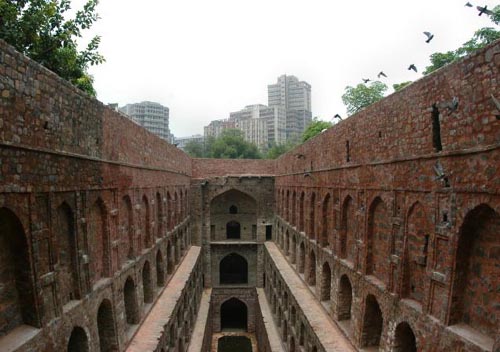Agrasen ki Baoli

Information on Agrasen ki Baoli (New Delhi) - History & Architecture
Agrasen ki Baoli, also recognized as Ugrasen ki Baoli or Sehingga Sain ki Baoli, has been chosen as a well looked after structure according to the Ancient Monuments and Archaeological Sites and Remains Act of 1958 by the ASI. The monument is basically an ancient step well which is 15-meter in width and 60-meter in length. It is located nearby to Connaught Place on Hailey Road, New Delhi. It is also close to another historical monument, the Jantar Mantar. Even though, the name of the individual who constructed the monument still remains unknown owing to lack of historical records, but, it is usually supposed that the Agrasen ki Baoli actually constructed by the renowned king Agrasen in the epic age of Mahabharat.
Agrasen ki Baoli Architecture
The structure is believed to have been reconstructed by the Agarwal community which relates to the origin of Maharaja Agrasen during the 14th century. Baoli is also recognized as bauri or baori and is derived from Sanskrit language. In the states of Gujarat and Rajasthan, step wells are referred to as baoli. Wells with temple steps or water temples were constructed in the early days in India and are considered to be amongst the most basic kinds of step wells and dates back to the era of Indus Valley Civilization in locations such as Dholavira. The structure is counted among quite a handful of its kind in Delhi.
Agrasen ki Baoli is known to have a design exclusive in nature and is supposed to prominently vary from the other traditional ones which are usually round in shape. The structure is divided into three different heights along with a curved area in each of the heights or levels which served as resting places. A few of the divisions of the structure along with its 103 steps remain continually submerged in water. The walls of the well made of stone are learnt to appear sharply delineated yet beautiful which creates a rectangle consisting of a sequence of layered walkways. The walkways disrupt the smooth running walls at three diverse levels, enabling the tourists to discover a variety of rooms and bays which were once used as places for carrying out puja or treated as refuges in the months of summer. However, it was learnt through an architectural viewpoint that the structure was most likely reconstructed in the Tughlaq era. Presently, the risky rooms have been protected with gates in order to prevent falls and also to keep away pigeons.
Agrasen ki Baoli History
It needs to be mentioned with regard to the name of the structure Agrasen ki Baoli that an Agarwal poet, Vibudh Shridhar in the year 1132 AD, stated in his piece of work Pasanahacariu about a powerful and affluent trader of Dhilli. Dhilli was later renamed as Delhi and the mentioned merchant named Nattal Sahu served as a minister under King Anang Pal III. Therefore, it was assumed that reconstruction of the ancient structure was within the earnings of the prosperous and well instituted Agarwal community in the 14th century.
Tourism Significance
A staircase leads one into the brilliantly constructed Baoli. As one descends more down, a fall in the temperature is experienced. A visit to this place provides a thrilling experience owing to the dark, constricted and dirty staircase. The structure is also believed to be quite popular among expert photographers owing to the unique play of light and shadow. Despite of the historical significance and scientific construction related to the monument, the place is hardly visited by tourists. But whatever it is, its historical importance is worth to pay visit and explore the architectural phenomenon, which is simply exceptional and magnificent.
- Andaman Nicobar Monuments
- Andhra Pradesh Monuments
- Assam Monuments
- Bihar Monuments
- Chhattisgarh Monuments
- New Delhi Monuments
- Goa Monuments
- Gujarat Monuments
- Haryana Monuments
- Himachal Pradesh Monuments
- Jammu and Kashmir Monuments
- Karnataka Monuments
- Kerala Monuments
- Madhya Pradesh Monuments
- Maharashtra Monuments
- Odisha Monuments
- Punjab Monuments
- Rajasthan Monuments
- Tamil Nadu Monuments
- Telangana Monuments
- Uttar Pradesh Monuments
- West Bengal Monuments